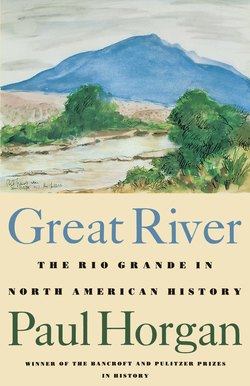Читать книгу Great River - Paul Horgan - Страница 12
На сайте Литреса книга снята с продажи.
Оглавление“… Since I offered to narrate the story, I shall start at the beginning, which is as follows.”
—PEDRO DE CASTAÑEDA, OF NÁXERA
1.
Creation
Space.
Abstract movement.
The elements at large.
Over warm seas the air is heavy with moisture. Endlessly the vast delicate act of evaporation occurs. The seas yield their essence to the air. Sometimes it is invisible, ascending into the upper atmosphere. Sometimes it makes a shimmer in the calm light that proceeds universally from the sun. The upper heavens carry dust—sea dust of salt evaporated from ocean spray, and other dust lingering from volcanic eruption, and the lost dust of shooting stars that wear themselves out against the atmosphere through which they fly, and dust blown up from earth by wind. Invisibly the volume of sea moisture and dust is taken toward land by prevailing winds; and as it passes over the coast, a new condition arises—the wind-borne mass reflects earth temperatures, that change with the earth-forms inland from the sea. Moving rapidly, huge currents of air carrying their sea burdens repeat tremendously in their unseen movement the profile of the land forms over which they pass. When land sweeps up into a mountain, the laden air mass rolling upon it must rise and correspond in shape.
And suddenly that shape is made visible; for colder air above the mountain causes moisture to condense upon the motes of dust in the warm air wafted from over the sea; and directly in response to the presence and inert power of the mountain, clouds appear. The two volumes—invisible warm air, immovable cold mountain—continue to meet and repeat their joint creation of cloud. Looking from afar calm and eternal, clouds enclose forces of heat and cold, wind and inert matter that conflict immensely. In such continuing turbulence, cloud motes collide, cling together, and in the act condense a new particle of moisture. Heavier, it falls from cold air through warmer. Colliding with other drops, it grows. As the drops, colder than the earth, warmer than the cloud they left, fall free of cloud bottom into clear air, it is raining.
Rain and snow fall to the earth, where much runs away on the surface; but roots below ground and the dense nerve system of grasses and the preservative cover of forest floors detain the runoff, so that much sky moisture goes underground to storage, even through rock; for rock is not solid, and through its pores and cracks and sockets precipitation is saved. The storage fills; and nearing capacity, some of its water reappears at ground level as springs which find upward release through the pores of the earth just as originally it found entry. A flowing spring makes its own channel in which to run away. So does the melt from snow clinging to the highest mountain peaks. So does the sudden, brief sheet of storm water. Seeking always to go lower, the running water of the land struggles to fulfill its blind purpose—to find a way over, around or through earth’s fantastic obstacles back to the element which gave it origin, the sea.
In this cycle a huge and exquisite balance is preserved. Whatever the amount of its element the sea gives up to the atmosphere by evaporation, the sea regains exactly the same amount from the water which falls upon the earth and flows back to its source.
This is the work, and the law, of rivers.
